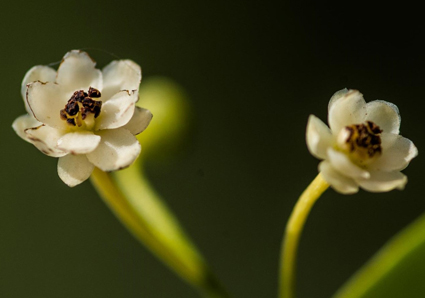Abstract
During fieldwork to assess biodiversity of the canga at the Serra de Campos, São Félix do Xingu, in the mountains of the Amazon rainforest, a new species of Lauraceae, Dicypellium anisum, was discovered, which is described and illustrated here. It is distinct from the other Dicypellium species by its shrubby habit, triplinerved leaves with domatia in the axils of the basal veins, and vegetative parts with aniseed scent.
References
- Alencar, R., Lima, R.A., Corrêa, R.G.C., Gottlieb, O.R., Marx, M.C., Silva, M.L., Maia, J.G.S., Magalhães, M.T. & Assumpção, R.M.V. (1971) Óleos essenciais de plantas brasileiras. Acta Amazonica 1: 41–43. https://doi.org/10.1590/1809-43921971013041
- Andrino, C.O., Barbosa-Silva, R.G., Lovo, J., Viana, P.L., Moro, M.F. & Zappi, D.C. (2020) Iron islands in the Amazon: investigating plant beta diversity of canga outcrops. PhytoKeys 165: 1–25. https://doi.org/10.3897/phytokeys.165.54819
- Aublet, J.B.C.F. (1775) Histoire des plantes de la Guiane Françoise, tome premier. Didot, London & Paris, 621 pp. http://www.botanicus.org/title/b11962094
- Bachman, S., Moat, J., Hill, A.W., de la Torre, J. & Scott, B. (2011) Supporting Red List threat assessments with GeoCAT: geospatial conservation assessment tool. ZooKeys 150: 117–126. http://doi.org/10.3897/zookeys.150.2109
- Chanderbali, A.S., van der Werff, H. & Renner, S.S. (2001) The relationships and historical biogeography of Lauraceae: evidence from the chloroplast and nuclear genomes. Annals of the Missouri Botanical Garden 88: 104–134. https://doi.org/10.2307/2666133
- CNCFlora (2012) Dicypellium caryophyllaceum in Lista Vermelha da flora brasileira versão 2012.2. Centro Nacional de Conservação da Flora. Available from: http://cncflora.jbrj.gov.br/portal/pt-br/profile/Dicypellium%20caryophyllaceum (accessed April 2023).
- Corrêa, M.P. (1984) Dicionário das plantas úteis do Brasil e das exóticas cultivadas, vol. 2. IBDF, Rio de Janeiro. 707 pp.
- Dallimore, W. (1912) Tulip Woods and Tulip Trees. Bulletin of Miscellaneous Information (Royal Botanic Gardens, Kew) 1912 (5): 241–245. https://doi.org/10.2307/4104590
- Escobar, R.G. (2002) Eugenol: propiedades farmacológicas y toxicológicas. Ventajas y desvantajas de su uso. Revista Cubana de Estomatología 39: 139–156.
- IUCN (2022) IUCN Standards and Petitions Committee. 2022. Guidelines for Using the IUCN Red List Categories and Criteria. Version 15.1. Prepared by the Standards and Petitions Committee. Available from: http://www.iucnredlist.org/documents/RedListGuidelines.pdf (accessed: June 2023).
- Kostermans, A.J.G.H. (1936) Revision of the Lauraceae I. Recueil des Travaux Botaniques Néerlandais 33: 719–757.
- Kostermans, A.J.G.H. (1957) Lauraceae. Reinwardtia 4: 193–256.
- Kurz, H. (2000) Revision der Gattung Licaria (Lauraceae). Mitteilungen aus dem Institut für Allgemeine Botanik in Hamburg 28/29: 89–221.
- Lamarck, J.B.A.P.M. de (1789–1792) Encyclopédie méthodique. Botanique, tome troisième. Panckoucke, Paris and Plomteux, Liège, pp. 1–759. https://doi.org/10.5962/bhl.title.824
- Linnaeus, C. (1753) Species plantarum, tomus I. Salvius, Stockholm, 560 pp. https://doi.org/10.5962/bhl.title.37656
- Martinelli, G. & Moraes, M.N. (2013) Livro vermelho da flora do Brasil. Andrea Jakobsson/Instituto de Pesquisas Jardim Botânico do Rio de Janeiro, Rio de Janeiro, 1100 pp.
- Martius, C.F.P. von. (1829) Ueber einige brasilianische Arzneimittel. Repertorium für die Pharmacie 31: 337–383.
- Meissner, C.F. (1864) Lauraceae. In: Candolle, A.L.P.P. de (Ed.) Prodromus systematis naturalis regni vegetabilis, pars decima quinta: sectio prior, sistens Lauraceas, Begoniaceas, Datiscaceas, Papayaceas, Aristolochiaceas et Stackhousiaceas. Masson, Paris, pp. 1–260, 503–516. https://doi.org/10.5962/bhl.title.286
- Merrill, E.D. & Perry, L.M. (1939) The Myrtaceous genus Syzygium Gaertner in Borneo. Memoirs of the American Academy of Arts and Sciences 18: 135–202. https://doi.org/10.2307/25058505
- Mez, C.C. (1889) Lauraceae americanae monographice descripsit. Jahrbuch des Königlichen Botanischen Gartens und des Botanischen Museums zu Berlin 5: 1–556. [https://www.biodiversitylibrary.org/item/52601]
- Nees von Esenbeck, C.G.D. (1833a) Annexa est Plantarum laurinarum secundum affinitates naturales expositio. Typis Grassii, Barthii et sociorum, Vratislaviae (Wroclaw), 25 pp. https://doi.org/10.5962/bhl.title.101773
- Nees von Esenbeck, C.G.D. (1833b) Revisio laurinarum a b. Sellowio in Brasilia collectarum et iam in Herbario Regio Berolinensi asservatarum. Adiecti sunt generum et specierum characteres. Linnaea 8: 36–51. [https://www.biodiversitylibrary.org/page/98929]
- Penagos Zuluaga, J.C., van der Werff, H., Park, B., Eaton, D.A.R., Comita, L.S., Queenborough, S.A. & Donoghue, M.J. (2021) Resolved phylogenetic relationships in the Ocotea complex (Supraocotea) facilitate phylogenetic classification and studies of character evolution. American Journal of Botany 108: 664–679. https://doi.org/10.1002/ajb2.1632.
- Rendle, A.B. (1917) A list of economic plants native or suitable for cultivation in the British empire. Bulletin of Miscellaneous Information (Royal Botanic Gardens, Kew) 1917 (7/8): 241–296. https://doi.org/10.2307/4113597
- Rizzini, C.T. & Mors, W.B. (1976) Botânica econômica brasileira. E.P.U./EDUSP, São Paulo, 207 pp.
- Rodrigues, W.A. (1968) Novo Dicypellium (Lauraceae) da Amazônia. Boletim INPA, Botânica, 25: 3–6. [https://repositorio.inpa.gov.br/handle/1/37953]
- Rohwer, J.G. (1988) The genera Dicypellium, Phyllostemonodaphne, Systemonodaphne and Urbanodendron (Lauraceae). Botanische Jahrbücher für Systematik, Pflanzengeschichte und Pflanzengeographie 110: 157–171.
- Rohwer, J.G. (1993) Lauraceae. In: Kubitzki, K., Rohwer, J.G. & Bittrich, V. (Eds.) The Families and Genera of Vascular Plants. Volume II. Flowering Plants—Dicotyledons. Magnoliid, Hamamelid and Caryophyllid Families. Springer-Verlag, Berlin, pp. 366–391. [https://www.springer.com/gp/book/9783540555094]
- Rohwer, J.G. (2000) Toward a phylogenetic classification of the Lauraceae: evidence from matK sequences. Systematic Botany 25: 60–71. https://doi.org/10.2307/2666673
- Rohwer, J.G. & Rudolph, B. (2005) Jumping genera: the phylogenetic positions of Cassytha, Hypodaphnis, and Neocinnamomum (Lauraceae) based on different analyses of trnK intron sequences. Annals of the Missouri Botanical Garden 92: 153–178. [https://www.jstor.org/stable/3298512]
- Rohwer, J.G., Richter, H.G. & van der Werff, H. (1991) Two new genera of neotropical Lauraceae and critical remarks on the generic delimitation. Annals of the Missouri Botanical Garden 78: 388–400. https://doi.org/10.2307/2399568
- Silva, A.S.L. & Secco, R.S. (2000) Mimosa dasilvae, uma nova Mimosaceae da Amazônia brasileira. Acta Amazonica 30: 449–452. https://doi.org/10.1590/1809-43922000303452
- Thiers, B. (2022) Index Herbariorum: a global directory of public herbaria and associated Staff. New York Botanical Garden’s Virtual Herbarium. Electronic database accessible at: http://sweetgum.nybg.org/science/ih/ (accessed 28 March 2022).
- Trofimov, D., Moraes, P.L.R. de & Rohwer, J.G. (2019) Towards a phylogenetic classification of the Ocotea complex (Lauraceae): classification principles and reinstatement of Mespilodaphne. Botanical Journal of the Linnean Society 190: 25–50. https://doi.org/10.1093/botlinnean/boz010
- van der Werff, H. (1986) Kubitzkia van der Werff, a new name for a genus of Neotropical Lauraceae. Taxon 35: 164–166. https://doi.org/10.2307/1221058
- van der Werff, H. & Endress, P.K. (1991) Gamanthera (Lauraceae), a new genus from Costa Rica. Annals of the Missouri Botanical Garden 78: 401–408. https://doi.org/10.2307/2399569


